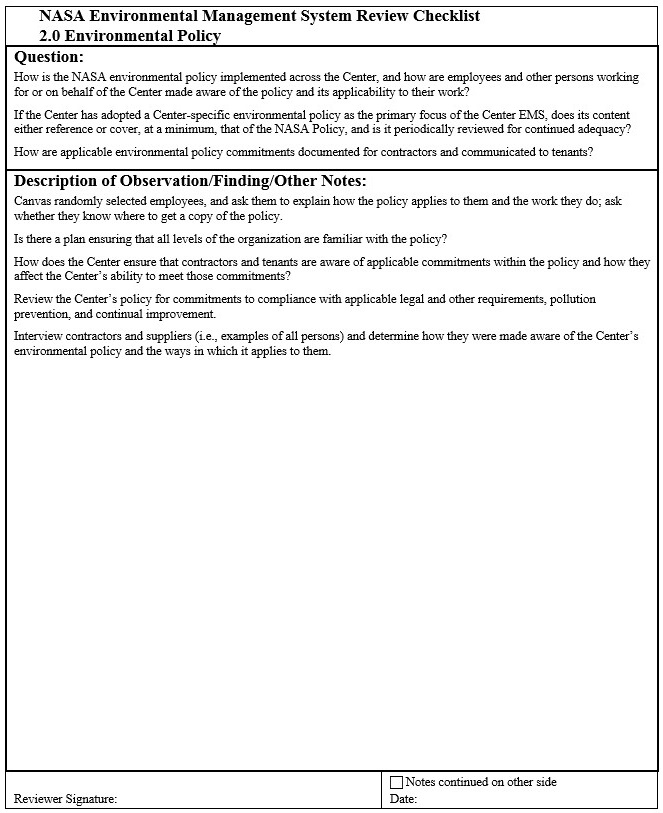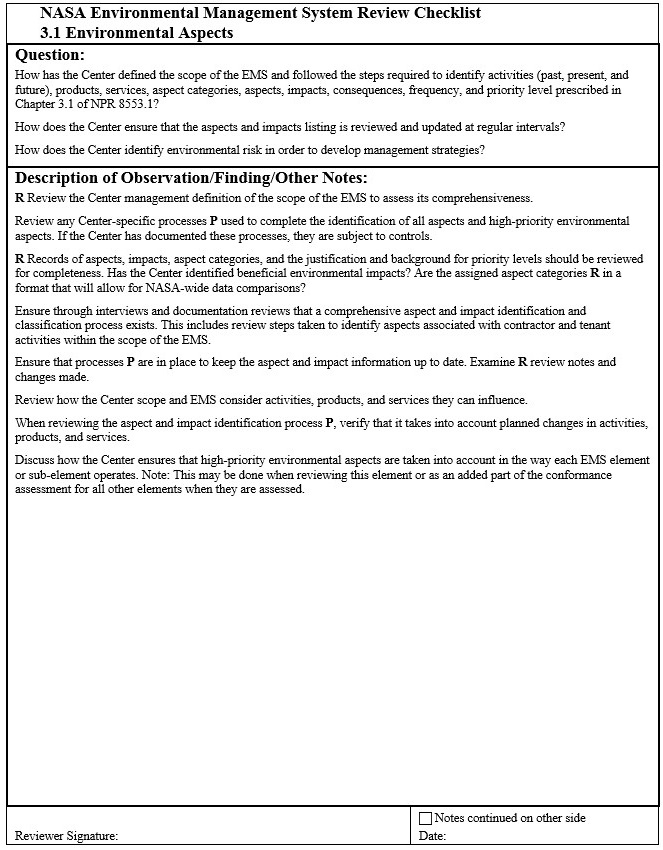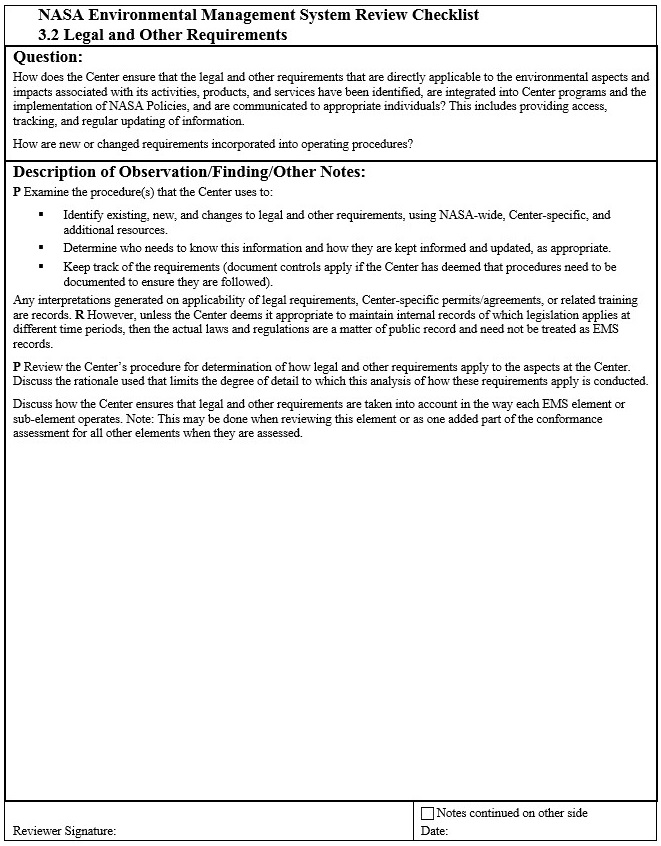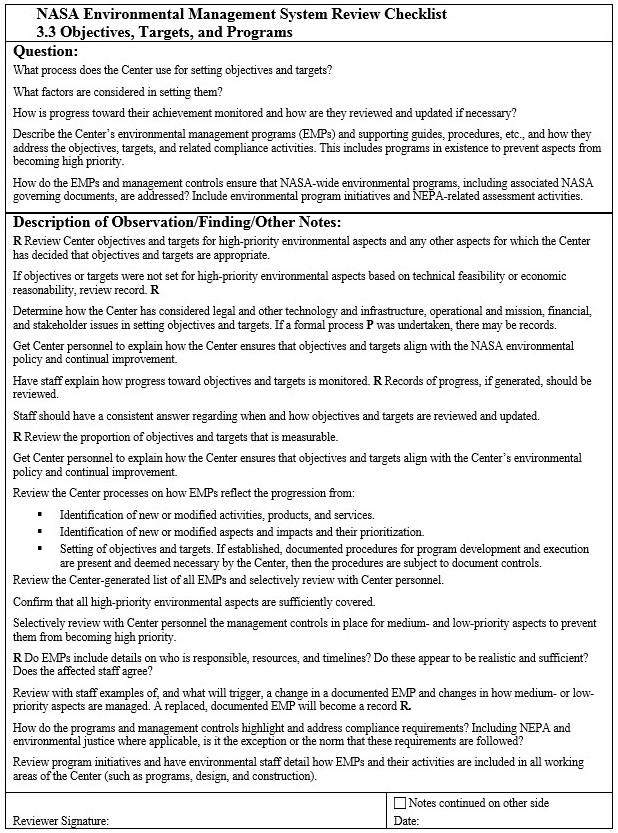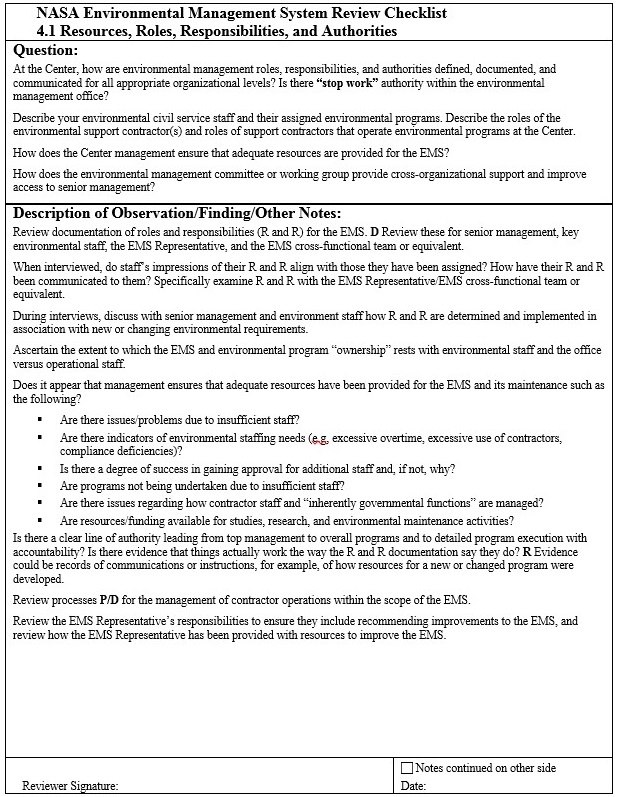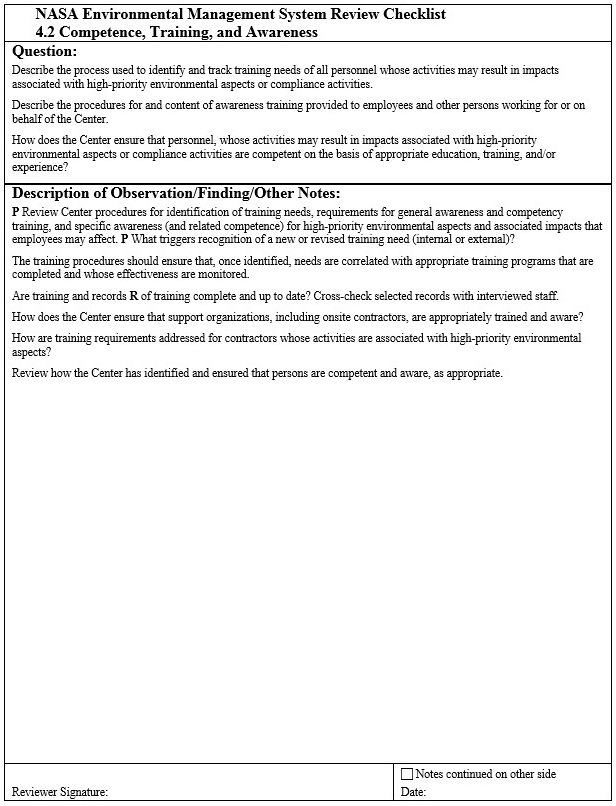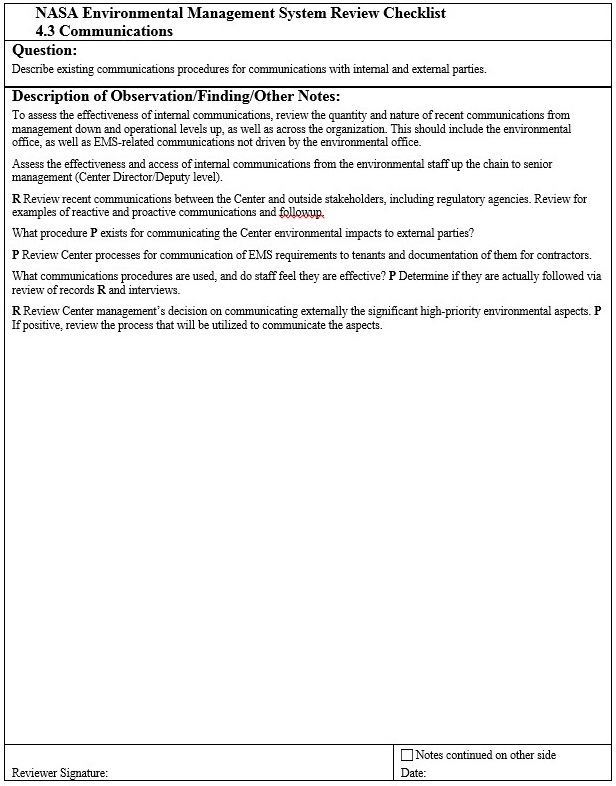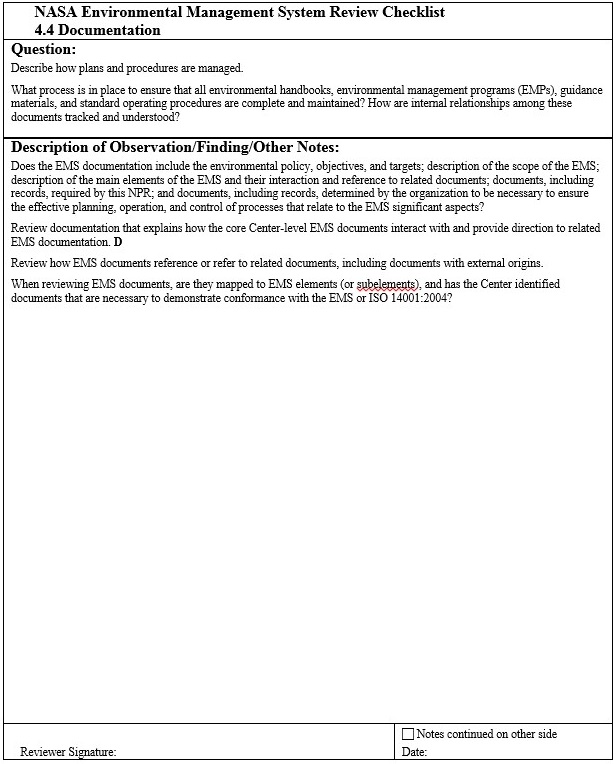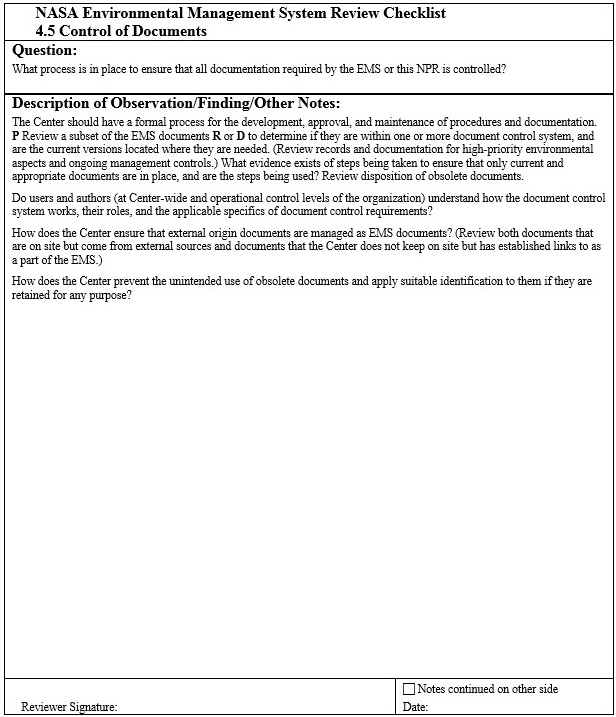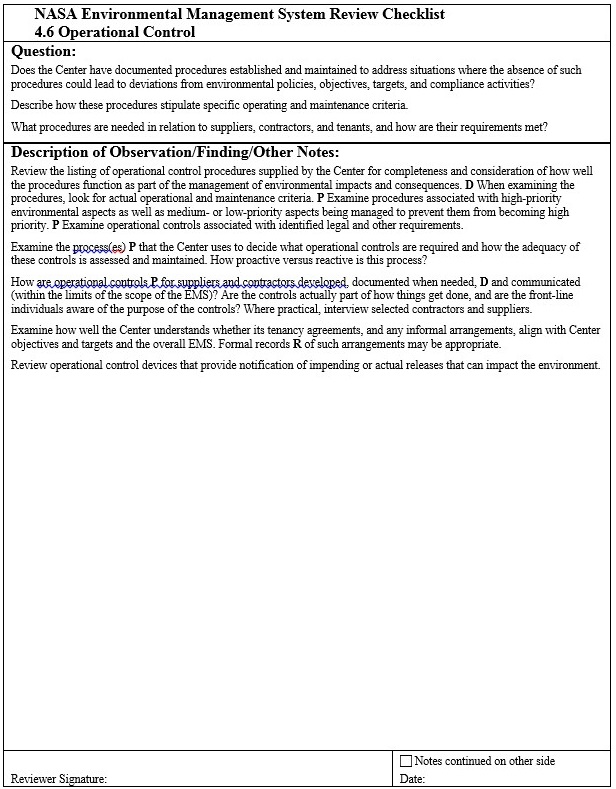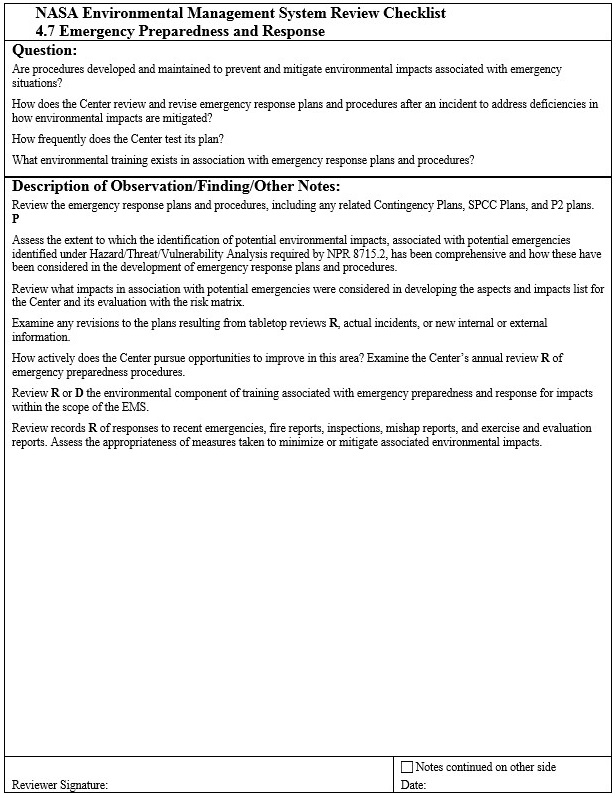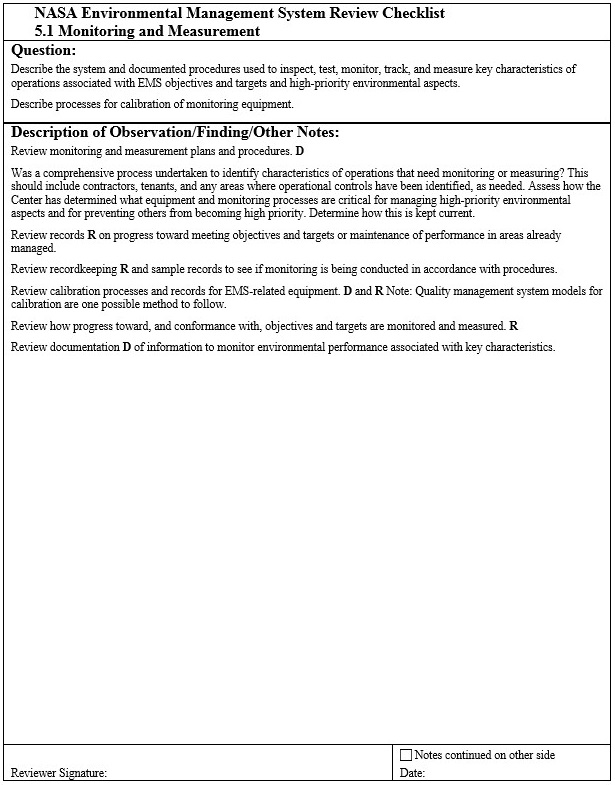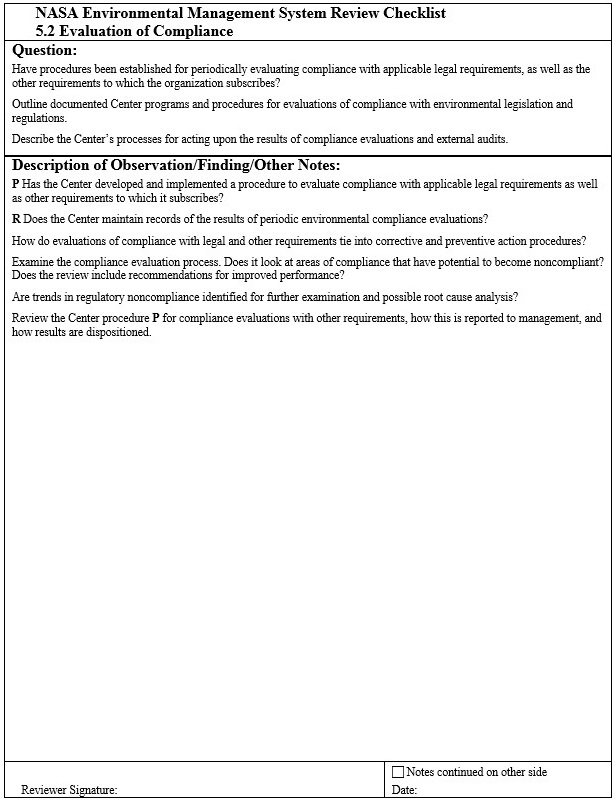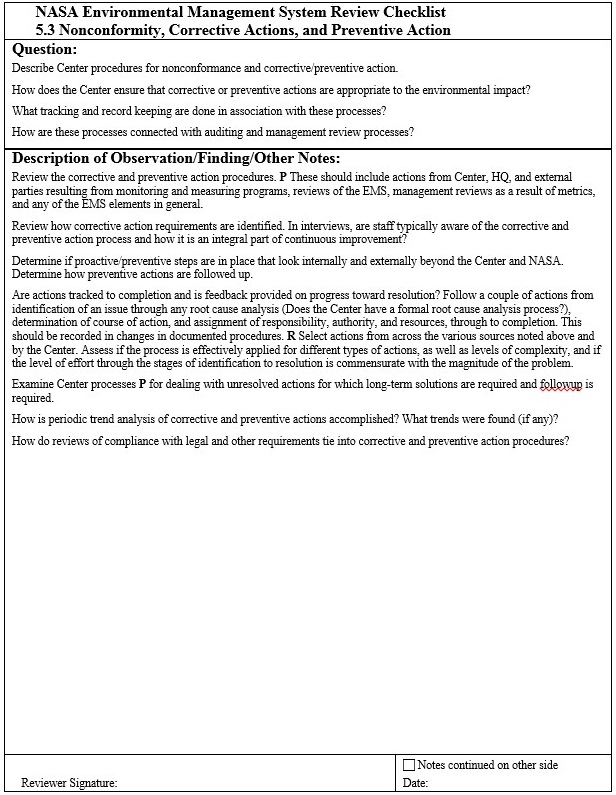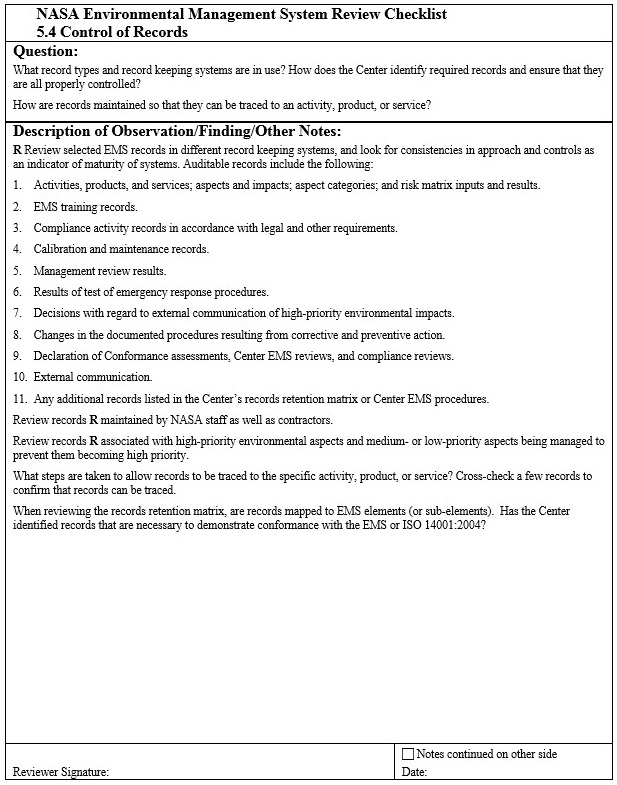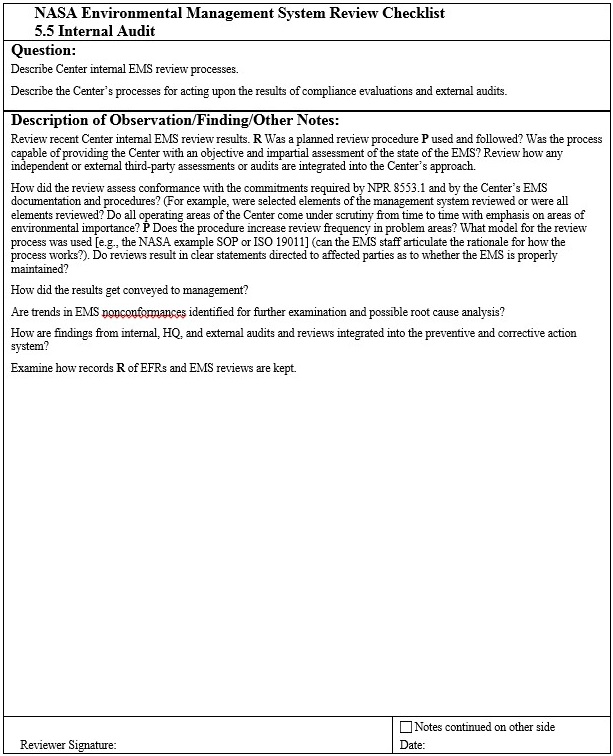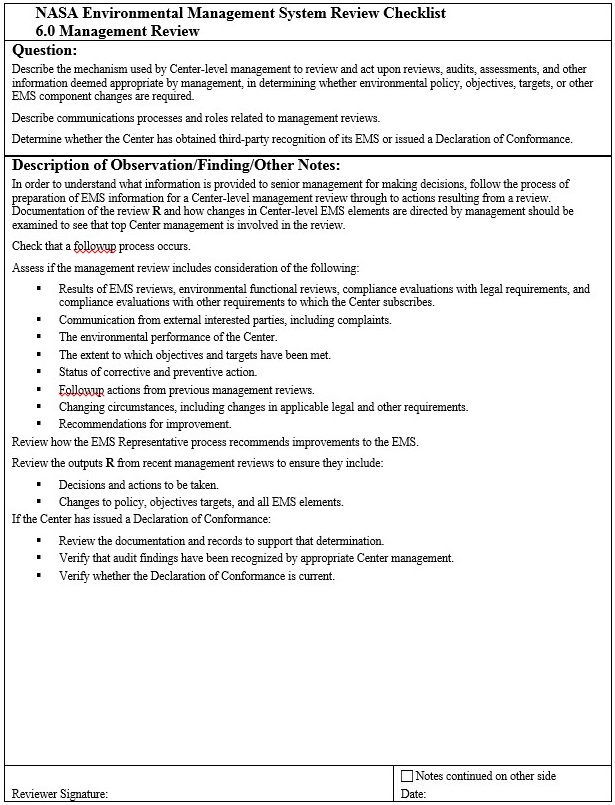![[NASA Logo]](../Images/nasaball.gif)
![[NASA Logo]](../Images/nasaball.gif) |
NASA Procedures and Guidelines |
This Document is Obsolete and Is No Longer Used.
|
|
P.1 Purpose
P.2 Applicability
P.3 Authority
P.4 Applicable Documents and Forms
P.5 Measurement/Verification
P.6 Cancellation
1.1 General Requirements
1.2 Roles and Responsibilities
3.1 Environmental Aspects
3.2 Legal and Other Requirements
3.3 Objectives, Targets, and Programs
4.1 Resources, Roles, Responsibility, and Authority
4.2 Competence, Training, and Awareness
4.3 Communication
4.4 Documentation
4.5 Control of Documents
4.6 Operational Control
4.7 Emergency Preparedness and Response
5.1 Monitoring and Measurement
5.2 Evaluation of Compliance
5.3 Nonconformity, Corrective Action, and Preventive Action
5.4 Control of Records
5.5 Internal Audit
Figure 1: Flow Diagram of Overall Process for Identifying Environmental Aspects and Impacts and Determining High-Priority Environmental Aspects
Figure 2: 5x5 Risk Matrix
Figure 3: Priority-Level Categories
Table 1: Environmental Aspect Categories
Table 2: NASA EMS Benefit (B)/Impact (I) Categories
Table 3: NASA EMS Probability Scoring
Table D-1: Example of an Environmental Aspect Risk Analysis Table
a. This NASA Procedural Requirement (NPR) describes NASA's Environmental Management System (EMS). An EMS is a system that does the following: (1) incorporates people, procedures, and work practices into a formal structure to ensure that the important environmental impacts of the organization are identified and addressed; (2) promotes continual improvement, including periodically evaluating environmental performance; (3) involves all members of the organization, as appropriate; and (4) actively involves senior management in support of the EMS. The purpose of the Agency EMS is to have a single, overall Agency approach to managing environmental activities that allows for efficient, prioritized system execution. The focus of the EMS is to improve environmental performance and to maintain compliance with applicable environmental legislation and regulations, as well as with other requirements to which NASA subscribes.
b. This NPR is intended to function in conjunction with the NASA Safety and Health Program, including loss-prevention priorities and risk management. As described in NPR 8000.4A, risk management includes two complementary processes: Risk-Informed Decision Making (RIDM) and Continuous Risk Management (CRM). Since EMS and risk management are analogous activities that proactively identify potential positive or negative impacts from NASA products, activities, and services, EMS supports an Agency approach to risk management that achieves appropriate coverage and manages environmentally driven risks. These risks are frequently cross-cutting in nature and simultaneously affect multiple programs, projects, and mission support activities.
a. This NPR applies to NASA Headquarters and NASA Centers, including Component Facilities and Technical and Service Support Centers, when determined to be appropriate by NASA HQ or its parent Center.
b. This language applies to the Jet Propulsion Laboratory (a Federally Funded Research and Development Center), other contractors, grant recipients, or parties to agreements only to the extent specified or referenced in the appropriate contracts or agreements.
Note: This statement alone is not sufficient to stipulate requirements for the contractor or grant recipient. The contract, grant, or agreement needs to state the requirement(s) from the NPR that apply.
c. An NPR requirement is identified by "shall," a good practice by "should," permission by "may" or "can," expected outcome or action by "will," and descriptive material by "is" or "are" (or another verb form of "to be").
d. The scope of the EMS at each Center consists of management-defined activities, products, and services applicable to the EMS, over which the Center has control and/or influence.
e. The scope of the HQ EMS includes:
(1) HQ operations, not affecting Center operations.
(2) HQ activities and programmatic decisions affecting Center operations.
f. Center Directors shall ensure that their Centers fully transition from conformance with requirements of NPR 8553.1 dated March 22, 2005, to those of this NPR, no later than 12 months from its effective date.
a. the National Aeronautics and Space Act of 1958, 42 U.S.C. 2473(c)(1), Section 203(c)(1).
b. Strengthening Federal Environmental, Energy, and Transportation Management, Executive Order (EO) 13423.
c. Federal Leadership in Environmental, Energy, and Economic Performance, Executive Order 13514.
a. Policy on Environmental Quality and Control, 14 CFR, Subpart 1216.1.
b. NPD 1000.3, The NASA Organization, as amended.
c. NPD 1210.2, NASA Surveys, Audits, and Reviews Policy.
d. NPR 8000.4, Agency Risk Management Procedural Requirements.
e. NPR 1441.1, Records Retention Schedules, as amended.
f. ISO 14001:2004, Second Edition, Requirements with Guidance for Use, International Organization for Standardization (ISO), 2004.
a. For Agency-level requirements, metrics shall be documented and reported in accordance with a schedule as established by the NASA HQ Environmental Management Division.
b. The NASA HQ Environmental Management Division shall conduct an environmental functional review (EFR) every three years.
NPR 8553.1A, NASA Environmental Management System, dated March 22, 2005.
|
|
|
|
|
1
|
08/28/2014
|
Revalidated NPR, updated format and made administrative corrections, to include adding EO 13514 in section P.3. |
1.1.1 The Director of each NASA Center and Component Facility, when determined to be appropriate by NASA HQ or its parent Center, shall develop, implement, and maintain an EMS in accordance with this NPR.
1.1.2 The Center/Component Facility Director shall seek external EMS recognition through the International Organization for Standardization (ISO) 14001 certification or an acceptable State-sponsored EMS recognition program or will issue an EMS Declaration of Conformance in accordance with Chapter 6 of this NPR.
1.1.3 Annually, the EMS and environmental management programs will be assessed and updated, and the results of the assessment shall be reviewed by Center management. (See Chapter 6, Management Review, for details.)
1.1.4 Management of each NASA Center shall develop the EMS scope. The scope will fully describe the organizational elements; activities, products, and services; and location(s), including Component Facilities, that come under the EMS.
1.1.5 The scope of the EMS will identify tenant organizations that are included in the EMS. For other tenant organizations, including lease arrangements, the EMS shall address the relationship and documentation that establishes environmental requirements for those tenant organizations, e.g., tenant-use agreement, lease document.
1.1.6 Management of each NASA Center shall ensure that those who draft procurement requirements coordinate with their procurement and environmental staff to ensure that contracts for contractor operation of Government-owned facilities require the contractor to comply with the provisions of EO 13423 and EO 13514, with respect to such facilities, to the same extent that NASA would be required to comply if NASA operated the same facilities.
1.2.1 The role of the NASA HQ Environmental Management Division is to implement applicable requirements of NPD 1000.3, The NASA Organization, related to Agency-wide environmental issues and initiatives, and NPD 8500.1, NASA Environmental Management.
1.2.2 The Assistant Administrator for Stragetic Infrastructure, as the senior Agency official responsible for providing executive and functional leadership for environmental management, is responsible for the following:
a. Ensuring that the HQ EMS Representative has the responsibilities and authority needed to implement and maintain the HQ EMS across Mission Directorates and Mission Support Offices.
b. Periodically reviewing the HQ EMS for status and viability and, if appropriate, leading the assessment, analysis, and preparation of environmental matters to be considered by the NASA Mission Support Council.
c. Monitoring implementation of recommendations of the NASA Mission Support Council related to the HQ EMS across Mission Directorates and Mission Support Offices.
d. Developing a Declaration of Conformance of the HQ EMS or ensuring participation in an external EMS recognition program.
1.2.3 The NASA HQ Environmental Management Division is responsible for the following:
a. Establishing and maintaining NASA environmental policy, requirements, and guidance.
b. Defining and maintaining NPR 8553.1, NASA Environmental Management System.
c. Establishing and maintaining guidance on the NASA EMS. (See Appendix D.)
1.2.4 The Center Director is responsible for the following:
a. Implementing NASA Environmental Policy and Requirements.
b. Defining the scope of the Center EMS.
c. As applicable, delegating Component Facility environmental management responsibilities to an appropriate Component Facility NASA authority.
d. Assigning roles and responsibilities to the Center EMS Representative.
e. Providing the authority needed for the EMS Representative to implement and maintain the Center EMS.
f. Providing resources for the effective operation and maintenance of the Center EMS.
g. Periodically reviewing the Center EMS for status and viability. (See Chapter 6, Management Review, for details.)
h. Reporting to the NASA HQ Environmental Management Division on EMS progress and metrics as requested.
1.2.5 Each NASA Center is responsible for the following:
a. Ensuring that requirements organizations shall determine the applicability of the EMS to its procurements, to satisfy EMS-related requirements of EO 13423 and EO 13514 and Federal Acquisition Regulations. When a determination is made that the EMS is applicable, procurement request packages will list applicable Agency and Federal environmental requirements.
b. Center management shall determine the applicability of the EMS to its tenants to satisfy EMS-related requirements of EO 13423 and EO 13514, subject to the limitations of tenancy agreements. When a determination is made that the EMS is applicable, Center management will ensure that EMS requirements for tenants are incorporated into future tenancy agreements.
c. Center management shall work with the HQ Environmental Management Division to define the scope of the HQ EMS.
d. Center management shall review and provide comments to the HQ Environmental Management Division on NASA environmental information, policy, requirements, and guidance.
1.2.6 The Component Facility NASA authority shall be responsible for implementation of an EMS commensurate with the environmental responsibilities delegated by the Center Director. The Component Facility EMS may be separate from, or a subset of, the Center EMS.
1.2.7 Requirements organizations responsible for the contract, in the case of a NASA-owned, contractor-operated facility, shall incorporate a requirement for implementing an EMS and the other requirements of EO 13423 and EO 13514, if determined appropriate, into the contract no later than the time of the next competition for the contract.
a. The above requirement will, at a minimum, specify an EMS that satisfies the EMS-related requirements of EO 13423 and EO 13514 and applicable Federal Acquisition Regulations.
b. If the contractor does not satisfy the requirement in paragraph 1.2.7 for an EMS, the requiring office may coordinate with their procurement and environmental officials to develop specifications for choosing and administering an EMS. Such conditions may include restrictions as to the type of acceptable EMS and provisions for appropriate NASA authority control or supervision of the EMS desired by Center management.
2.1.1 Purpose. To establish the overall environmental goals of the organization or facility (e.g. the Center) and the primary focus of the EMS.
2.1.2 NPD 8500.1, is NASA's internal environmental policy. NPD 8500.1 establishes that NASA shall maintain compliance with applicable environmental legislation and regulations and with other requirements to which NASA subscribes. NPD 8500.1 includes a commitment to prevention of pollution and continual improvement of its environmental program. NPD 8500.1 also commits to incorporate sustainable practices to the extent practicable throughout programs, projects, and activities. In addition,
NPD 8500.1 establishes more specific responsibilities for each NASA employee, each NASA organizational element, and appropriate HQ and Center organizations and managers.
2.1.3 NPD 8500.1 is available to both the public and the NASA community through NASA's Web pages and NODIS at http://nodis3.gsfc.nasa.gov/ and is consistent with 14 CFR, subpart 1216.1.
2.1.4 The Center may develop an environmental policy as an element of its EMS. The Center Director shall ensure that this policy contains a commitment to continual improvement, prevention of pollution, and compliance with applicable legal and other requirements to which the Center subscribes, as related to its environmental aspects. The following requirements apply to the policy:
a. The Center Director shall ensure that the policy is appropriate to the nature, scale, and environmental impacts of the activities, products, and services of the Center.
b. The Center Director shall ensure that the policy provides a framework for setting and reviewing environmental objectives and targets.
c. Center Directors adopting this approach will ensure that the Center's environmental policy is communicated to all persons working for or on behalf of the Center.
d. The Center Director shall ensure that the environmental policy is documented, maintained, and made available to the public.
3.1 Environmental Aspects
3.1.1 Purpose. To identify priority environmental aspects and impacts essential to developing NASA's EMS.
a. Center management shall follow each of the steps described in Figure 1 below. Center employees are expected to apply best professional judgment when applying this process.
b. The following diagram and notes illustrate the recommended order of steps for this process. Center management shall complete all steps.

Figure 1: Flow Diagram of Overall Process for Identifying Environmental Aspects and Impacts and Determining High-Priority Environmental Aspects
3.1.2 Flow Diagram Notes
a. In steps 1 to 3, a list of environmental aspects is developed, and the environmental aspects are grouped into categories.
b. Once environmental aspects have been categorized, steps 4 to 6 assign applicable impact categories and associated impact severity and frequency.
c. To establish the level of priority for an environmental aspect, the risk or benefit associated with each associated environmental impact is defined in step 7, using a combination of the severity and probability of the environmental impact.
3.1.3 Step 1: List all activities, products, and services.
a. Within the scope of its EMS, each Center Director shall identify all activities, products, and services under its control, and those activities, products, and services over which it should be expected to have control pursuant to its mission, based on the nature and scale of its operations.
3.1.4 Step 2: Identify environmental aspects and impact(s).
a. Center management shall determine the environmental aspects and impacts associated with the activities, products, and services identified in step 1.
b. Past activities, products, and services with environmental impacts that potentially require management in the present or future shall be considered.
c. Environmental impacts associated with activities, products, and services that are planned for the future with a reasonable degree of certainty shall be considered.
d. In the identification of present and future environmental impacts, Center management shall consider normal, abnormal, and emergency conditions.
(1) Abnormal and emergency conditions that can be reasonably foreseen shall be considered.
(2) Where separate environmental impacts have been identified based on consideration of normal, abnormal, and emergency conditions, each environmental impact shall be subject to steps 4 through 7 below.
(3) Where environmental impacts or their severity or probability (See steps 4, 5, and 6) vary, depending upon different conditions, these variations may need to be considered as separate environmental impacts when determining priority level, or the highest severity and frequency scores may be chosen.
3.1.5 Step 3: Group environmental aspects and impacts for manageability, and assign environmental aspect categories.
a. Where practical, Centers may group environmental aspects and associated environmental impacts to ensure that further analysis is manageable.
b. Center management shall take the output from step 2, and any grouping that has been conducted in step 3, and assign environmental aspect categories as appropriate.
c. Where an environmental aspect and its associated environmental impacts may apply to more than one environmental aspect category, the environmental aspect category shall be selected based on best professional judgment.
d. The Center is free to determine the category in which an individual environmental aspect belongs, but may not add or change the following list of 16 environmental aspect categories. Examples of areas included in the environmental aspect categories are provided. Aspect category 16 allows for Center-specific, unique aspects.
Table 1: Environmental Aspect Categories
| 1 | Air Emissions, including: Stationary and point sources. Mobile sources. Ozone-depleting substances. Fugitive emissions. Greenhouse gases. |
| 2 | Cultural Resources, including: Archaeological resources. Historic resources. |
| 3 | Efficient Fleet Management, including: Acquisition of alternative-fuel vehicles. Alternative-fuelinfrastructure. Fleet size reductions. Fuel use reductions. |
| 4 | Energy/Water Consumption, including: Reduction in energy use. Reduction in water consumption. Use of renewable energy. |
| 5 | Environmental Impacts Review, including: Environmental justice. National Environmental Policy Act (NEPA). Noise. Non-ionizing radiation. Odors. Socioeconomic impacts. |
| 6 | Fuel, Oils, and Lubricants, including: Container storage. Storage tanks. Transformers. Hydraulic systems. Spill prevention control and countermeasures. |
| 7 | Hazardous materials, including: Hazardous materials storage. Emergency planning and response. Community right-to-know. Reduction in the quantity of toxic and hazardous chemicals and materials acquired, used, or disposed of (e.g., reuse). |
| 8 | Regulated waste, including: Collection and storage. Off-site shipment and disposal. Hazardous waste. Hazardous waste recycling. Hazardous waste treatment, storage, and disposal facilities. Medical waste. State-regulated industrial or chemically contaminated wastes. Universal and special waste. |
| 9 | Natural resources, including: Land use and resources. Wetlands and floodplains. Threatened and endangered species. Wildlife. Ecosystems. Oceans and coastal zones. |
| 10 | Remediation/Restoration, including: Comprehensive Environmental Response, Compensation, and Liability Act sites. Resource Conservation and Recovery Act sites. Tank sites. |
| 11 | Solid waste (non-hazardous), including: General trash. Construction waste. Solid waste landfills. Waste prevention and recycling. |
| 12 | Sustainable acquisition, including: Affirmative procurement/Green purchasing. Electronics stewardship. |
| 13 | Sustainable facilities, including: Encroachment. High-performance and sustainable buildings. |
| 14 | Toxic substances, including: Asbestos. Lead products (including paint). Mercury. Polychlorinated biphenyls. Pesticides/herbicides. Radioactive materials. |
| 15 | Water quality, including: Drinking water. Groundwater. Storm water. Sanitary or domestic wastewater. Industrial wastewater. Eutrophication. |
| 16 | Other, Center-unique aspects: |
3.1.6 Step 4: Categorize environmental benefits (B)/impacts (I).
a. A "high-priority environmental aspect" is a NASA environmental aspect that shall be managed to:
(1) Avoid or prevent a serious adverse environmental impact.
(2) Create a substantial beneficial environmental impact.
b. Classify each individual or grouped environmental aspect by assigning associated environmental benefits/impacts into one or more of the following seven categories:
(1) Safety.
(2) Natural and Cultural Resources (NCR).
(3) Environmental Legal/Regulatory Implications (L&R).
(4) Performance.
(5) Reputation and Stakeholder Relationships (R&S).
(6) Cost.
(7) Schedule.
c. Both adverse impacts (I) and beneficial impacts (B) shall be considered within the framework of the table of NASA EMS Benefits (B)/Impacts (I) categories listed in Table 2.
d. The Center may adjust the EMS B/I scoring in the table below to meet the needs of the site. The objective of this scoring system is to ensure that only a few aspects will receive the highest scores in any category. Center management shall ensure that the adjustments to the scoring are both geared to drive this objective and are documented.
Table 2: NASA EMS Benefit (B)/Impact (I) Categories
| Safety | Score |
|---|---|
| (B/I) Negligible benefit or impact | 1 |
| (B) Avoids source of nuisance or irritant (I) Nuisance or irritant | 2 |
| (B) Avoids minor injury or human health impact (I) Minor injury or human health impact | 3 |
| (B) Eliminate source of substantial injury/lost time or human health impact (I) Potential source of substantial injury/lost time or human health impact | 4 |
| (B) Eliminate potential source of death or disabling injury (I) Potential source of death or disabling injury | 5 |
| Natural and Cultural Resources (NCR) | Score |
|---|---|
| (B/I) Negligible impact or benefit on natural or cultural resources. | 1 |
| (B) Results in minor improvement to natural or cultural resources. (B) Results in minor improvement in sustainable practices. (I) Minor impact on natural or cultural resources. | 2 |
| (B) Supports conservation of natural or cultural resources. (B) Results in moderate improvement in sustainable practices. (B) Moderate reduction of impacts on natural or cultural resources. (I) Moderate impact on natural or cultural resources. | 3 |
| (B) Prevents substantial impact to onsite, protected, natural or cultural resources. (B) Results in substantial restoration or conservation of/improvements to onsite protected natural or cultural resources. (B) Results in substantial improvement in sustainable practices. (I) Substantial onsite impact on protected natural or cultural resources. | 4 |
| (B) Prevents off-site damage to natural or cultural resources. (B) Results in expanded off-site natural or cultural resources. (B) Results in sustainable off-site improvement in sustainable practices. (I) Off-site damage to natural or cultural resources. | 5 |
| Legal and Regulatory Implications (L&R) | Score |
|---|---|
| (B/I) Negligible regulatory action. | 1 |
| (B) Improve relationship with regulators. (B) Avoids an informal notice. (I) Informal notice. | 2 |
| (B) Avoids a potential notice of violation with no fine. (B) Minor incentive, such as eliminates a minor regulatory requirement. (I) Notice of violation with no fine. | 3 |
| (B) Major incentive, such as regulatory relief. (I) Significant fine, consent agreement, unilateral order, or noncompliance with legal and other requirements. | 4 |
| (B) Significant incentive, such as eliminates significant regulatory requirement. (I) Work stoppage. (I) Criminal sanctions. | 5 |
| Performance | Score |
|---|---|
| (B/I) Negligible impact to mission/institutional capability. | 1 |
| (B) Temporary enhancement of mission/institutional capability. (I) Temporary loss of mission/institutional capability. | 2 |
| (B) Moderate enhancement to mission/institutional capability. (I) Moderate loss of mission/institutional capability. Workaround available. | 3 |
| (B) Significant enhancement to mission/institutional capability. (I) Significant loss of mission/institutional capability. Workaround available. | 4 |
| (B) Permanent enhancement to mission/institutional capability. (I) Permanent loss of mission/institutional capability. | 5 |
| Reputation and Stakeholder Relationship (R&S) | Score |
|---|---|
| (B/I) Negligible media interest or effect on NASA reputation or stakeholder relations. | 1 |
| (B) Minor increase in positive public inquiries or stakeholder support. (I) Minor adverse effect on NASA reputation or stakeholder relations. | 2 |
| (B) Moderate increase in positive public inquiries or stakeholder support. (I) Moderate adverse effect on NASA reputation or stakeholder relations. | 3 |
| (B) Substantial increase in positive public inquiries or stakeholder support. (I) Substantial adverse effect on NASA reputation or stakeholder relations. | 4 |
| (B) Major increase in positive public inquiries or stakeholder support. (I) Major increase in negative public inquiries/mandatory meeting attendance. (I) Potential mission impact. | 5 |
| Cost | Score |
|---|---|
| (B/I) Negligible benefit or cost impact. | 1 |
| (B/I) Net benefit or cost of less than $50,000. | 2 |
| (B/I) Net benefit or cost of $50,000 to less than $100,000. | 3 |
| (B/I) Net benefit or cost of $100,000 to $500,000. | 4 |
| (B/I) Net benefit or cost of greater than $500,000. | 5 |
| Schedule | Score |
|---|---|
| (B/I) Negligible schedule change. | 1 |
| (B) Accelerates mission/project schedule by 1 day to less than 1 month. (I) Delay to mission/project schedule by 1 day to less than 1 month. | 2 |
| (B) Accelerates mission/project schedule by 1 month to less than 3 months. (I) Delay to mission/project schedule by 1 month to less than 3 months. | 3 |
| (B) Accelerates mission/project schedule by 3-6 months. (I) Delay to mission/project schedule by 3-6 months. | 4 |
| (B) Accelerates mission/project schedule by greater than 6 months. (I) Delay to mission/project schedule by greater than 6 months. | 5 |
3.1.7 Step 5: Determine the environmental benefit (B)/impact (I) severity score for each category.
a. For each environmental aspect, Center management shall use the environmental impact category in Table 2 to determine the numerical score (benefit or impact) for the applicable impact category with the highest potential B/I.
b. Center management shall ensure that severity scores include the effect of management controls in place to mitigate environmental impacts or secure existing benefits.
3.1.8 Step 6: Determine the probability score for each aspect category.
a. For each environmental aspect, Center management shall assign a numerical, probability-based score to each environmental aspect, using the applicable B/I categories and the probability rating of the benefit/impact.
b. Center management shall ensure that probability scores include the effect of management controls in place to mitigate environmental impacts or secure existing benefits.
c. Taking into account the historical record of such an incident occurring, Center management shall use the table below to determine the probability score of the scenario occurring.
d. Center management shall assign the score that corresponds with the probability rating.
Table 3: NASA EMS Probability Scoring
| Probability Rating | Ordinal Value | Description of Risk Probability (Examples) |
|---|---|---|
| Very Low | 1 | Qualitative: Very unlikely to occur, management not required in most cases. Either strong controls are in place or are not required. OR Frequency: Minimum of once every 10+ years |
| Low | 2 | Qualitative: Not likely to occur, management not required in all cases. Current controls have minor limitations/uncertainties, may need to be strengthened. OR Frequency: Once every 5 years to once every 10 years |
| Moderate | 3 | Qualitative: May occur, management required in some cases. Current controls exist with some uncertainties, need for review is evident. OR Frequency: Once a year to once every 5 years |
| High | 4 | Qualitative: Highly likely to occur, most cases require management attention. Current controls have significant uncertainties, corrective actions likely. OR Frequency : Once a month to once a year |
| Very High | 5 | Qualitative: Nearly certain to occur, requires immediate management attention. Current controls have little or no effect, implementation of corrective action is mandatory. OR Frequency: Continuous to once a month. |
3.1.9 Step 7: Determine overall priority level.
a. Center management shall determine the priority level of the associated environmental aspect based on the environmental benefit/impact severity versus probability using the 5x5 Risk Matrix illustrated in the following figure.

Figure 2: 5x5 Risk Matrix

Figure 3: Priority-Level Categories
The overall priority level for each environmental aspect is determined by the benefit/risk associated with the most severe B/I scores.
If contractor personnel conduct steps 1 through 6, the appropriate NASA authority personnel shall review and approve, modify, or reject the data or request further analysis, in addition to making the overall risk-ranking determination.
3.1.10 Step 8: Set objectives and targets.
a. Center management shall determine which environmental aspects, associated with activities, products, and services, require objectives and targets as defined in Chapter 3.3.
b. Consideration shall be given to the goals that have been established within EO 13423.
3.2.1 Purpose. To establish and maintain a procedure to identify all relevant legal and other requirements applicable to the environmental aspects of NASA's activities, products, and services.
a. The NASA Center management shall develop, implement, and maintain procedures for the evaluation of legal and other requirements, as well as proposed changes to existing legal and other requirements, for applicability to Center activities and operations.
b. The legal and other requirements shall be taken into account in establishing, implementing, and maintaining the Center's EMS.
c. The relationship to the environmental aspects shall be established for the legal and other requirements to which the Center subscribes.
d. The Center management shall evaluate NASA-wide and Center agreements and commitments for their applicability to the Center's environmental aspects.
e. The applicable legal and other requirements shall be made available to appropriate individuals at the Center.
f. The Center management shall provide information identified under Step 3.2.a to Mission Directorates and Mission Support Offices when requested.
g. The Center management shall consult with their Office of Chief Counsel, as necessary, in fulfilling responsibilities under Chapter 3.2.
3.3.1 Purpose. To set forth requirements for establishing environmental objectives and targets that demonstrate commitment consistent with the intent of NASA environmental policy and the environmental aspects established through the EMS process.
a. Objectives and targets shall be established at all appropriate organizational levels as needed for the implementation and maintenance of the EMS.
b. Objectives and targets shall be established consistent with the environmental policy.
c. The determination of the need for objectives and targets shall be made by the appropriate NASA authority. However, the actual objectives and targets may be suggested by other interested parties.
d. When establishing objectives and targets, management at each Center shall consider the following:
(1) Legal and other requirements to which the organization subscribes.
(2) Priority environmental aspects.
(3) Available technology options and infrastructure.
(4) Operational, mission, and mission-related activities.
(5) Financial resources.
(6) Interests and views of stakeholders.
e. Specific objectives and targets that are technically feasible and economically reasonable shall be established by Center management for high-priority environmental aspects.
f. If the determination is made that a high-priority environmental aspect cannot be addressed with one or more objectives and targets due to being technically infeasible or economically unreasonable, the rationale behind this determination shall be documented.
g. Objectives and targets shall be made measurable where practical.
h. Objectives and targets shall be reviewed and updated as needed.
i. Center management shall develop objectives and targets to address the goals established in Section 2 of EO 13423 and EO 13514.
j. Objectives and targets may be established by Center management for medium- or low-priority aspects, as necessary, to address other Federal or Agency goals and commitments.
k. Environmental management programs (EMPs) shall be established, implemented, and maintained by Center management for achieving the objectives and targets.
l. EMPs shall accomplish the following:
(1) Designate responsibility for achieving objectives and targets at each relevant function and level of organization.
(2) Demonstrate that NASA is addressing its identified objectives and targets.
(3) Address major compliance activities if applicable.
(4) Identify required resources (technical and financial) to carry out the EMPs.
(5) Establish the timeframes in which objectives and targets are to be achieved.
4.1.1 Purpose. To identify roles, responsibilities, and authorities that provides an organizational structure for implementing and maintaining the EMS.
a. The Center Director shall:
(1) Allocate resources for the effective operation and maintenance of the EMS.(2) Define, document, and communicate the roles, responsibilities, and authorities to facilitate an effective EMS.
(3) Appoint an EMS Representative with appropriate authority and background and training.
b. The EMS representative shall:
(1) Exercise the authority necessary to implement and maintain the Center EMS.
(2) Document and communicate roles, responsibilities, and authorities to facilitate effective implementation of the Center EMS.
(3) Request resources for the effective operation and maintenance of the Center EMS.
(4) Establish a Center EMS cross-functional team of organizations that affect environmental aspects or have support roles including mission organizations and mission support organizations, such as facilities, energy management, vehicle management, logistics, procurement, legal, safety, health, and emergency response, or other means to accomplish an equivalent function, with assigned roles and responsibilities.
(5) Coordinate high- and medium-priority aspects and associated environmental management plans with the cognizant programs and projects at their Centers.
(6) Periodically assess, review, and report to top Center management on the performance of the Center EMS.
(7) Make recommendations to top Center management for improvement of the EMS.
4.2.1 Purpose. To identify training requirements needed to ensure and maintain awareness and competence for the EMS.
a. Employees engaged in activities associated with EMS environmental aspects or compliance activities shall receive appropriate training, as determined by the Center.
b. Center management shall identify environmental training requirements associated with its environmental aspects and the EMS to include:
(1) Programs mandated by environmental laws and regulations.
(2) Those who need to be trained and those who will do the training.
(3) A description of how the environmental training will be accomplished and how often and which EMS element, high-priority aspect, or legal or other requirement is driving the training.
c. Employees and persons working for or on behalf of the organization shall be aware of the following areas, based on activities in which they are engaged:
(1) Adverse and beneficial environmental impacts associated with the high-priority environmental aspects of their work that they may affect, and the benefits of improved environmental performance.
(2) Requirements of the EMS applicable to their work, to include the environmental policy and associated processes, and the consequences associated with their deviation from these requirements.
(3) Their roles and responsibilities in achieving conformity with the requirements of the EMS.
d. If it is appropriate for contractor employees to have EMS training, Center management shall ensure that the procurement statement of work specifies training requirements and which employees require training. It will also specify how contractor employees can obtain training, particularly those contractors whose work is associated with the high-priority aspects.
e. Training records shall be maintained in accordance with Chapter 5.4.
4.3.1 Purpose. To establish procedures for internal and external communication related to environmental aspects and the EMS.
a. The Center management shall establish, implement, and maintain a procedure regarding the communication of its environmental aspects and the EMS, to include the following:
(1) Internal communication to various organizational levels.
(2) Receiving, recording, and responding to relevant communications from external parties.
b. The Center management shall follow existing communications procedures (or create new procedures as necessary) in communicating with internal and external parties.
c. Unless an authorized individual at the Center determines that disclosure of information regarding high-priority environmental aspects would harm an interest protected by one of the Freedom of Information Act exemptions, or disclosure is prohibited by law, Centers shall provide documents to the public if so requested.
d. EMS requirements shall be documented within contracts no later than the time of the next contract competition.
e. The Center managers shall also communicate applicable EMS requirements to tenants, subject to the limitations of tenancy agreements.
4.4.1 Purpose. To identify EMS documentation.
a. Center Directors shall ensure that EMS documentation includes, as a minimum:
(1) Environmental policy that sets the overall goals for the EMS.
(2) The scope that establishes the boundaries for the EMS.
(3) The objectives and targets established for continual improvement of environmental performance.
(4) The EMS manual, or other documents, which provides a description of the EMS elements and their interaction as developed, implemented, and maintained by the Center.
(5) Policies that provide overall direction for the Center's processes.
(6) This NPR and other procedures that support and provide details of the Center's processes, particularly those related to the high-priority aspects (operational controls).
(7) Records that document the results of EMS activities and documents and records required by this NPR.
b. This NPR establishes additional requirements for EMS documents and documented procedures (see Appendix C).
c. Each Center may establish additional documentation associated with its EMS.
4.5.1 Purpose. To establish and maintain procedures for EMS document control and maintenance.
a. Center management shall establish document control procedures to ensure that the following occurs:
(1) Periodic review and update of EMS documents as necessary.
(2) Removal of obsolete EMS documents.
b. Obsolete EMS documents that are retained for legal and historical reasons shall be identified with the reason for retention and archived per Section 5.4 of this NPR.
c. EMS documents and documented procedures shall be written to be:
(1) Legible.
(2) Dated (with dates of revision and a summary of changes).
(3) Readily available in locations where essential operations occur.
(4) Identifiable.
(5) Maintained in an orderly manner.
(6) Approved by appropriate Center Management prior to issue.
d. The Center EMS representative shall ensure that electronic or hardcopy versions of EMS documents under the EMS Representative's control meet the requirements of Step 4.5.c.
e. Documents of external origin that are determined by the Center to be a necessary component of the EMS, such as compliance documents, shall be identified as such and their distribution controlled.
4.6.1 Purpose. To develop, implement, and maintain operational controls and operational control procedures for activities associated with high-priority environmental aspects, to manage all other environmental aspects to keep them from becoming high-priority as needed, and to manage NASA environmental policy and compliance activities.
a. Center management shall ensure that operational controls and operational control procedures associated with high-priority environmental aspects:
(1) Stipulate specific operating and maintenance criteria.
(2) Be communicated to suppliers, contractors, and tenants as appropriate.
b. Center managers shall document applicable procedures within contracts no later than by the time of the next contract competition.
c. The Center management shall ensure that operational controls are in place to mitigate adverse environmental impacts or secure existing benefits associated with non-high-priority environmental aspects, prevent those environmental aspects from becoming high-priority, manage NASA environmental policy and compliance activities, and remain in place unless it is determined that they are no longer required.
d. If a contractor or tenant operates a Government facility or vehicles, or affects high-priority aspects, the contract and tenant agreements shall include the requirements and operational controls to support the EMS and to move toward achieving the goals established by EO 13423 and EO 13514.
4.7.1 Purpose. NASA Center managers shall ensure that the Centers emergency preparedness and response procedures/plans address potential incidents and their attendant adverse environmental impacts.
a. Based on the activities in which they are engaged, employees shall be provided with appropriate training on emergency preparedness and response requirements:
(1) Associated with environmental aspects and impacts identified in Chapter 3.1.
(2) As externally required under legal and other requirements.
(3) Associated with other potential emergency situations such as fire or natural disasters.
b. Procedures to meet emergency preparedness training, planning, procedures, and requirements may be contained within Center Emergency Preparedness Program Plans; Integrated Contingency Plans; Center Spill Prevention, Control, and Countermeasure Plans; and/or Pollution Prevention Plans.
c. The Center management shall periodically test the emergency plans with respect to its environmental aspects, where practical.
d. The Center management shall periodically review its emergency plans with respect to its environmental aspects, especially after an emergency situation, or test and, where necessary, revise the plans.
5.1.1 Purpose. To perform periodic monitoring and measurement of the EMS in order to evaluate the success of the EMS and NASA's attainment of its environmental compliance objectives.
a. NASA Center Directors shall establish, implement, and maintain documented procedures to track, monitor, and measure the key characteristics of operations associated with EMS objectives and targets, as well as EMS high-priority environmental aspects.
b. Center Directors may establish metrics to monitor and measure the key characteristics.
c. Equipment used for monitoring shall be appropriately maintained and calibrated and calibration records will be maintained.
d. For Agency-level requirements, metrics shall be documented and reported in accordance with a schedule established by the NASA HQ Environmental Management Division.
5.2.1 Purpose. To evaluate compliance with all applicable legal and other requirements.
a. NASA Center Directors shall develop, implement, and maintain a procedure to describe the methods used to evaluate compliance with applicable legal requirements and to ensure that all requirements identified in Section 3.2 of this NPR are evaluated for compliance.
b. The Center Directors shall also establish a method to ensure compliance with the other requirements to which the organization subscribes.
c. HQ Environmental Management Division-led EFRs shall be conducted every three years and include an environmental compliance evaluation.
d. The EFRs shall be performed in accordance with the requirements of NPD 1210.2, NASA Surveys, Audits, and Reviews Policy.
e. Center Directors shall support HQ Environmental Management Division-led EFRs as necessary to ensure that Center programs, projects, facilities, systems, and operations comply with all environmental requirements.
f. The Center managers shall conduct internal, annual environmental compliance evaluations during the years that HQ Environmental Management Division-led EFRs are not conducted, with each Center reviewing compliance with all requirements (as identified in Section 3.2) over a three-year period.
g. If the Center utilizes the HQ EFR for part of its internal compliance evaluation, the Center shall coordinate its audit schedule with the HQ EFR to ensure that all appropriate requirements and appropriate organizational elements are evaluated within the three-year period.
h. The Center managers shall ensure that the personnel performing compliance assurance are competent.
i. Records shall be maintained for the process utilized to ensure compliance with the legal and other requirements and for the results of the evaluations.
5.3.1 Purpose. To establish, implement, and maintain a procedure for defining responsibility and authority and for identifying, handling, and investigating nonconformities.
a. NASA Center managers shall establish, implement, and maintain procedures to identify and track actual and potential nonconformities, corrective and preventive action, and necessary changes to be made to the EMS.
b. Preventive and corrective actions shall be made suitable for the magnitude of the environmental impact.
c. Action shall be taken to mitigate any environmental impacts caused by a nonconformity, to identify the cause, and to provide for both initiation and completion of corrective action to preclude recurrence.
d. The need for action to prevent nonconformities shall be evaluated and appropriate actions shall be designed to avoid their occurrence.
e. Results of corrective and preventive action shall be recorded.
f. The effectiveness of corrective and preventive action shall be reviewed.
5.4.1 Purpose. To establish, implement, and maintain procedures for the identification, storage, protection, retrieval, retention, and disposal records that demonstrate conformity to the requirements of the ISO 14001:2004 EMS Standard, this NPR, EO 13423 and EO 13514.
a. Center management shall establish and maintain a records retention schedule for EMS records per NPR 1441.1, NASA Records Retention Schedules.
b. Environmental records shall be legible, identifiable, and traceable to an activity, product, or service.
c. Environmental records shall be identified, maintained, and stored in a manner consistent with NPR 1441.1, NASA Records Retention Schedules, that:
(1) Allows for their ready retrieval.
(2) Protects them from loss, damage, or deterioration.
(3) Provides for their appropriate disposal.
d. A list of records that have been identified as pertaining to the EMS is provided in Appendix C.
e. External compliance records are not subject to EMS record requirements but shall be both maintained according to external requirements and readily available.
5.5.1 Purpose. To assess conformance to this NPR's requirements in the development, implementation, and maintenance of the EMS through the following:
a. NASA HQ Environmental Management Division-led EFRs.
b. ISO 14001:2004 EMS Certification Audits.
c. Independent Declaration of Conformance assessments of Center EMSs.
d. Center-led internal, annual EMS reviews.
5.5.1 The NASA Center Directors shall support HQ Environmental Management Division-led EFRs as necessary to ensure that Center programs, projects, facilities, systems, and operations comply with all environmental requirements and requirements of this NPR.
5.5.2 The Center Directors shall establish and maintain programs and procedures for internal annual EMS reviews that address the responsibilities and requirements for all aspects of the audit and the determination of audit criteria, scope, frequency, and methods.
5.5.3 The Center management shall conduct internal, annual EMS reviews, during the years that HQ Environmental Management Division-led EFRs are not conducted. When conducting their annual EMS reviews, the Centers may utilize the NASA EMS Checklist (see Appendix E).
5.5.4 At a minimum, in conducting the annual EMS reviews, management at each Center shall internally review all elements of its EMS for conformance with this NPR, as applicable to its internal suborganizations, over a three-year period.
5.5.5 If the Center utilizes the EMS audit portion of the HQ EFR for part of its internal audit process, the Center shall coordinate its audit schedule with the HQ EFR to ensure that all appropriate organizational elements are audited within the three-year period.
5.5.6 The HQ Environmental Management Division-led EFRs shall be conducted every three years.
5.5.7 Results of previous EFRs shall be considered by the HQ Environmental Management Division when conducting EFRs.
5.5.8 Where relevant, Center Directors shall consider results of previous HQ Environmental Management Division-led EFRs, independent Declaration of Conformance assessments, Center-led annual EMS reviews, and compliance evaluations with applicable regulations when conducting EMS reviews and evaluations of compliance with applicable environmental regulations.
5.5.9 Results of annual EMS reviews, Declaration of Conformance assessments, and compliance evaluations with applicable environmental regulations and EFRs shall be completely documented and provided to Center Senior Management.
5.5.10 HQ Environmental Management Division and Center auditing procedures shall be designed to address auditor competence, objectivity, and impartiality in the audit process.
6.1.1 Purpose. To involve Senior Management in the review and evaluation of the EMS to ensure that it continues to be suitable, adequate, and effective and meets the requirements of this NPR, EO 13423, and EO 13514.
a. The Center Senior Management shall review the EMS annually to ensure its continuing suitability, adequacy, and effectiveness.
(1) Management shall ensure that these reviews include assessing opportunities for improvement and the need for changes to the EMS, including the environmental policy and environmental objectives and targets.
(2) Records of the management reviews shall be retained per Section 5.4 of this NPR.
6.2.1 The Center EMS Representative is responsible for the following:
a. Reporting to the Center Director and NASA HQ Environmental Management Division on the results of Center-led annual EMS reviews and the status and viability of the Center EMS.
b. Reporting to the Center Director on the results of independent Declaration of Conformance assessments, as applicable.
c. Reviewing and updating, as necessary, Center objectives and targets.
d. Reviewing the determination(s) of technical feasibility and economic reasonableness where it was decided not to set objectives and targets to address high-priority environmental aspects or EO 13423 and EO 13514 goals.
6.2.2 The EMS management review shall include the following inputs to determine any necessary changes to and opportunities for continual improvement of the EMS:
a. Results of internal audits.
b. Environmental compliance evaluations with legal and other requirements.
c. Communications from external interested parties.
d. Environmental performance of the Center, to include the progress on objectives and targets.
e. Status of corrective and preventive actions.
f. Follow up actions from previous management reviews.
g. Changing circumstances both physically and in requirements.
h. Recommendations for improvement.
6.3.1 Outputs from the management review include decisions and actions related to changes to environmental policy, objectives, targets, and other elements of the EMS consistent with the commitment to continual improvement.
6.3.2 The results of the management review, including EMS status, shall be recorded.
6.3.3 Per the instructions for implementing EO 13423, the Center Director shall obtain third-party recognition of its EMS, such as ISO 14001 certification, or shall issue a Declaration of Conformance that the Center EMS conforms to applicable requirements of this NPR, EO 13423, and EO 13514.
6.3.4 For a Declaration of Conformance, the EMS may be considered fully implemented when the following conditions have been met:
a. It has been subject to an audit by a qualified party outside the control or scope of the EMS. The Center may utilize the HQ Environmental Management Division-led EFR or an independent Declaration of Conformance assessment to satisfy this requirement. (See paragraph 5.5.)
b. The audit findings have been recognized by appropriate Center management.
c. The Center Director has issued a document declaring conformance. (See Appendix D,
Section D.18.c for an example of a Declaration of Conformance.)
6.3.5 The Declaration of Conformance shall be renewed every three years in conjunction with the requirement for an audit by a qualified party outside the control or scope of the EMS. This should be done in conjunction with the annual EMS review required by section 6.2.2, a-h.
Acceptable State-Sponsored EMS Recognition Program--an acceptable State-sponsored EMS recognition program must involve, at a minimum, equivalent requirements such as those for EMS Declaration of Conformance.
Annual EMS Review--a review of a Center EMS following EMS audit principles and techniques.
Competence--a demonstrated ability to apply knowledge and skills (training, education, and experience) defined by the organization as appropriate for all personnel whose work may be associated with an environmental aspect or who are designated as internal auditors.
Component Facility--a secondary NASA installation reporting to, but possibly geographically separated from, the primary NASA field entity, a NASA Center.
Continual Improvement--the recurring process of enhancing the EMS in order to achieve improvements in overall environmental performance in line with NASA environmental policy and the NASA Vision and Mission.
Declaration of Conformance--an assessment by the appropriate senior manager who is accountable for implementation of the EMS and ensures that an EMS is fully implemented as established by requirements of the instructions for implementing EO 13423. The responsible manager shall ensure that the assessment includes results of a formal EMS audit by a qualified party outside the control or scope of the EMS.
Document--electronic, written, or printed information, policy, requirement, procedure, or guideline that requires regular review or maintenance.
EMS Documentation--EMS documents specified in this NPR (Appendix C).
Environmental Management System (EMS)--a system that incorporates people, procedures, resources, responsibilities, and work practices in a formal structure to address the development, implementation, achievement, and review of the environmental policy.
EMS Audit--a systematic, documented, and periodic verification process for objectively obtaining and evaluating evidence to determine whether an organization is conforming to its EMS and for communicating the results of this process to management. The environmental management portion of EFRs and Center internal annual EMS reviews are forms of EMS audits. The results of the environmental management portion of an EFR can be used to support a Declaration of Conformance.
EMS Cross-Functional Team--personnel, representing a cross section of the organization, who assist with the development, implementation, maintenance/operation, and continual improvement of the Center EMS, with roles and responsibilities defined by Center management. The team may consist of procurement, legal, budget, facility, energy management, vehicle fleet management, environmental management, technical support, and other personnel, as appropriate, to implement NASA environmental policy, sustainable practices, and this NPR.
EMS Record--a record that has been identified as pertaining to the EMS.
EMS Representative--the NASA individual who manages the EMS and is responsible for reporting to Senior Management and the NASA HQ Environmental Management Division on EMS performance and the results of EFRs, audits, and management reviews.
Environmental Aspects--elements of NASA's activities, products, or services that can interact with the environment. Environmental aspects constitute the elements of NASA's activities, products, or services over which NASA has control, and which it can manage.
Environmental Compliance Evaluation--a systematic, documented, and periodic verification process for objectively obtaining and evaluating evidence to review operations and practices related to meeting environmental, regulatory requirements and for communicating the results of this process to management. The compliance portion of EFRs and Center reviews of compliance are forms of environmental compliance evaluation.
Environmental Functional Review (EFR)--a functional assessment, led by the HQ Environmental Management Division, of environmental management, compliance, and related activities at a NASA Center. EFRs are conducted in accordance with NPD 1210.2, NASA Surveys, Audits, and Reviews Policy, and are a form of Survey, Audit, and/or Review (SAR), as defined therein.
Environmental Impact--any change to the environment, whether adverse or beneficial, wholly or partially resulting from NASA's activities (past, present, or future), products, or services. Environmental impacts are changed by the management of environmental aspects. Environmental impacts may occur as a result of normal, abnormal, or emergency situations.
Environmental Management Program--programs that are established, implemented, and maintained in order to achieve the organization's objectives and targets.
Environmental Objective--an overall environmental goal, arising from the environmental policy, that NASA sets for itself to achieve and that is quantified where practical.
Environmental Target--a detailed performance requirement, quantified where practical and applicable to NASA, that arises from the environmental objectives and that needs to be set and met to achieve those objectives.
External EMS Recognition Program--includes the ISO 14001 and/or an acceptable State-sponsored EMS recognition program.
ISO 9000--a series of international quality management system standards developed by quality experts from around the world for use by organizations that either want to implement their own in-house quality systems or want to ensure that suppliers have appropriate quality systems in place. The standards were developed under the auspices of ISO, one of the world's principal voluntary standards development bodies.
ISO 14000--a series of environmental management standards developed by ISO. The ISO 14000 standards are designed to provide an internationally recognized framework for environmental management, measurement, evaluation, and auditing. The standards are designed to be flexible enough to be used by any organization of any size, in any field.
Legal and Other Requirements--those requirements that NASA or a Center is regulated to or has committed to meeting. Legal requirements include Federal, State, and local laws, regulations, ordinances, or policies to which NASA is subject under Federal law; Office of Management and Budget circulars; Executive orders; enforceable Agency agreements; contractual obligations; and international obligations. Other requirements include internal standards, voluntary Agency agreements, Presidential initiatives, industry codes or practice, and non-regulatory guidelines.
ANASA Online Directives Information System (NODIS)--an Internet application used for creating NASA directives and for automating the coordination/clearance process. Approved NASA directives are maintained in NODIS, enabling users to retrieve, view, and print NASA directives electronically.
Noncompliance--a failure to meet an applicable legal or other requirement.
Nonconformance--a failure to meet a NASA or Center EMS-specified requirement.
Operational Controls--measures taken to accomplish the following: manage environmental aspects; mitigate adverse environmental impacts or secure beneficial environmental impacts; and manage NASA environmental policy and compliance activities. These may include training, communication, procedures and practices, monitoring and measurement activities, and the installation and operation of physical structures or equipment.
Operational Control Procedures--documented procedures in place to accomplish the following: manage high-priority environmental aspects; mitigate adverse environmental impacts or secure beneficial environmental impacts; and manage NASA environmental policy and compliance activities.
Record--an electronic, written, or printed object that provides evidence of what was done or has occurred in the past.
| B | Benefit |
| CFR | Code of Federal Regulations |
| EFR | Environmental Functional Review |
| EMP | Environmental Management Program |
| EMS | Environmental Management System |
| EO | Executive Order |
| EPA | Environmental Protection Agency |
| H | High (action priority category) |
| HQ | Headquarters |
| I | Impact |
| ISO | International Organization for Standardization |
| L | Low (action priority category) |
| L&R | Environmental Legal and Regulatory Implications; environmental consequence category |
| M | Medium (action priority category) |
| NCR | Natural and Cultural Resources Impacts (environmental consequence category) |
| NEPA | National Environmental Policy Act |
| NODIS | NASA Online Directives Information System |
| NPD | NASA Policy Directives |
| NPR | NASA Procedural Requirements |
| OSHA | Occupational, Safety, and Health Administration |
| R&S | Reputation and Stakeholder Relationships (environmental consequence category) |
| SATERN | System for Administration, Training, and Educational Resources for NASA |
a. EMS Documents and Documented Procedures:
(1) NASA NPDs and NPRs (paragraphs P.3, P.4, and Appendix F).
(2) Objectives and Targets and EMPs (paragraph 3.3).
(3) Metrics (paragraphs P.5 and 5.1).
b. Procedures (written or non-written).
(1) EFR procedures (paragraphs 5.2 and 5.5).
(2) Declaration of Conformance (paragraphs 1.1 and 1.2, Chapter 6).
c. EMS Records:
(1) Results of HQ Environmental Management Division-led EFRs (paragraphs 5.2 and 5.5).
(2) Management review results (Chapter 6).
(3) Metrics reports (paragraph 5.1).
a. EMS Documents and Documented Procedures:
(1) Objectives and targets for high-priority environmental aspects (paragraph 3.3).
(2) Environmental management programs (paragraph 3.3).
(3)Roles, responsibilities, and authorities for implementation of EMS (paragraph 4.1).
(4) EMS procedures applicable to tenants (paragraph 1.1.5).
(5) Operational Control procedures associated with high-priority environmental aspects (paragraph 4.6).
(6) Procedures to track, monitor, and measure the key characteristics of operations associated with EMS objectives and targets and associated with high-priority environmental aspects (paragraph 5.1).
(7) Metrics (paragraph 5.1).
(8) Declaration of Conformance (Chapter 6).
b. EMS Procedures (written or non-written):
(1) Identification of applicable Federal, State, local, facility-specific, and permit-driven legal and other requirements (paragraph 3.2).
(2) Communications procedures (paragraph 4.3).
(3) EMS training procedures (paragraph 4.2).
(4) EMS documentation (paragraph 4.4).
(5) Document control (paragraph 4.5).
(6) Operational Control procedures for activities associated with EMS high-priority environmental aspects (paragraph 4.6).
(7) Emergency preparedness (paragraph 4.7).
(8) Nonconformance and corrective action tracking (paragraph 5.3).
(9) EMS internal audit procedures (paragraph 5.5).
c. EMS Records:
(1) Activities, products and services, aspects, impacts, and Risk Matrix results (paragraph 3.1).
(2) EMS training records (paragraph 4.2).
(3) Compliance activity records in accordance with legal and other requirements (paragraph 5.2).
(4) Calibration and maintenance records (paragraph 5.1).
(5) Results of tests of emergency response procedures (paragraph 4.7).
(6) Results of independent Declaration of Conformance assessments, Center-led annual EMS reviews, and reviews of compliance with local regulations (paragraphs 5.2 and 5.5).
(7) Communication with external parties (paragraph 4.3).
(8) Decisions made with regard to external communication of high-priority environmental aspects (paragraph 4.3).
(9) Changes in the documented procedures resulting from corrective and preventive action (paragraph 5.3).
(10) Management review results (Chapter 6).
a. The EMS establishes an organizational structure to minimize environmental risks that could impede meeting mission objectives.
b. It encourages the efficient use of resources, freeing operations and maintenance funds.
a. The Center's own environmental policy should be signed by the Center Director.
b. The external communication of the policy can easily be accomplished by posting the policy on the Center's Web site. In addition, a paper copy of the environmental policy should be available upon request.
a. The annual updating of the environmental aspects provides an opportunity to keep the core implementation team engaged in the EMS process.
b. For those independent contractors that do not come under EO 13423, the requiring office may coordinate with their procurement and environmental officials to include appropriate language supporting the NASA Center EMS in the resulting contract.
c. Major changes in the mission or facilities should be managed within the EMS. For large projects, the National Environmental Policy Act (NEPA) can be utilized to evaluate the environmental impact of the changes. A determination should be made whether a change in the environmental aspects is warranted as well as other changes in the EMS. For smaller projects, a simple review of the change may be adequate to determine its impact on environmental aspects and the EMS.
d. The table on the next page provides examples of how environmental aspect categories might be ranked within the risk matrix. Both beneficial and adverse environmental impacts have been evaluated. Assumptions have been made with regard to the magnitude of the environmental aspect/aspect category. Each Center will need to determine the individual ranking for each environmental aspect/aspect category at its location.
Table D-1: Example of an Environmental Aspect Risk Analysis Table
a. The Centers should pay particular attention to the other requirements to which they subscribe. These can be voluntary or mandatory, based on their origin. These do not include documents developed from within the Center, but they should include all pertinent documents from NASA HQ and other organizations outside of the Center.
b. Each legal and other requirement should be linked to at least one environmental aspect or an element of the EMS.
c. The listing of the legal and other requirements should also include a short description of the requirement and/or its purpose.
a. Objectives and targets may be established to address any medium- or low-priority environmental aspect that a Center determines is necessary to manage or maintain to ensure that the environmental aspect does not become a high priority.
b. The objectives and targets should be aligned with the Center's mission.
c. Objectives and targets should be established for all applicable goals in EO 13423 and EO 13514, Strengthening Federal Environmental, Energy, and Transportation Management, even if they are not identified as high-priority aspects.
d. High-priority aspects and their accompanying objectives and targets need to be addressed regardless of the organization having responsibility for their management. If necessary, the EMS Representative should elicit the support of Center management to ensure that this is accomplished.
e. The determination of whether a high-priority aspect and associated objective and target should be managed within the EMS depends on whether it is within the scope of the EMS. If it is within the scope, then it should be considered, even if it includes aspects that are part of a NASA program spread across numerous locations.
f. If there are ongoing compliance issues at the Center, objectives and targets to correct the situation are appropriate. It may also be appropriate to consider past compliance issues for objectives and targets to ensure that they do not reappear.
g. The Center should ensure that the number of objectives and targets can be capably managed by the organization. Particular attention should be given to the number of objectives and targets assigned to one organization.
h. For an objective and target spread across the entire Center, it can be beneficial to establish an EMS cross-functional team to manage the objective, target, and program rather than depend on one organization to generate and implement the EMPs. The team should be provided with training on how to function as a team and solve basic problems using the simple quality tools.
i. When establishing objectives, targets, and metrics, consider creating relative measures for those objectives and targets that are affected by changes in the Center's activity levels such as launches or number of employees and contractors onsite.
j. The status of the objectives, targets, and programs should be reported to Center management on a routine basis, e.g., quarterly.
k. With the ownership of the objectives, targets, programs, and associated metrics assigned to various members of the EMS cross-functional team, routine updates provide an opportunity to engage the team in the process on a frequent basis.
a. Resources required for the EMS should include human resources, organizational infrastructure, technology, and financial resources.
b. Resources are required not only in the development and implementation of the EMS but, just as importantly, in the ongoing maintenance of the EMS. Given that resources are often limited, it is effective to spread the resource requirements to many organizations and personnel and, thereby, use the EMS Representative to coordinate those resources. The resource requirements should be spread to all levels within the organization, since often those personnel lower in the organization have more time and interest in taking on the EMS responsibilities.
c. Center managers need to demonstrate support for the EMS in order for the effort to be successful. They should be engaged in the process and fully aware of progress and process status. Frequent updates on progress during development and implementation can be very beneficial. Management should show their support through such means as e-mails, letters, and meetings. Once the EMS is established, managers should be briefed on performance measures on a routine basis, e.g., quarterly, so that they can see the improvements that are being made and provide guidance on areas needing further improvement.
d. Both civil service employees and contractors, to the extent specified or referenced in the appropriate contract, need to be engaged in the EMS. This can be accomplished initially by forming an active EMS cross-functional team. The team should help develop every element in the EMS, even if it means just reviewing and providing feedback on what already exists or is being developed by others. The team becomes the conduit into all of the Center's organizations and keeps their organizations and its management appraised of progress. Once the EMS is implemented, the team assists in the ongoing maintenance and improvement of the EMS.
e. Forming teams to address the various objectives, targets, and programs within the EMS can expand the involvement of employees and contractors in the process and engage more personnel in the EMS. This also takes the workload off of a limited management resource pool. Once these teams have been established, it is beneficial to replace team members over time to keep new ideas flowing into the system.
f. All Center personnel should understand their roles, responsibilities, and authority for the EMS. It can be helpful to develop the roles, responsibilities, and authority for each directorate, organization, or office. Start with a list of general roles, responsibilities, and authority based on the high-priority aspects and what the employees and contractors can do to minimize that impact. Then develop specific roles, responsibilities, and authority based on what is unique to that directorate, organization, or office.
g. The EMS requires the designation of an EMS Representative. This person can come from any level but must be capable of performing the tasks specified in the requirements section of this NPR, as set out in Section 4.1, Resources, Roles, Responsibility, and Authority. That capability is based on a thorough understanding of the EMS, to include its development, implementation, and maintenance. The EMS Representative must also be in a position to advise Center management on the status of the EMS and make recommendations on its improvement.
h. It can be beneficial to integrate the EMS and the environmental program once the EMS has been established. The entire environmental program can benefit from the tools that reside within the EMS. It can even be beneficial to integrate the EMS with other management systems at the Center such as the Quality Management System or OSHA's Voluntary Protection Program. There are some parts of these management systems that are very similar and, as such, benefit from integration and a reduction in duplication.
a. Awareness training may be accomplished by formal classroom training, on-line training, or as a part of the employee's on-the-job training requirements.
b. The Center should review the contractors' training records to ensure that their employees have received the environmental training that is required of the civil service employees.
a. To facilitate communication among NASA, and its stakeholders, and the surrounding communities, to maintain and improve the EMS, Center managers should commit to proactive communications with interested parties. The EMS should support appropriate inclusion of local participation, consistent with the objectives of E.O. 13352, Facilitation of Cooperative Conservation.
b. There are numerous ways to communicate the environmental policy, EMS, and personal environmental responsibility to employees, contractors, and tenants. The key is to develop a communications plan with many of the following methods outlined as steps in that plan:
(1) Intranet Site
(2) Training Programs
(3) Global E-mails
(4) Team Meetings
(5) All Employee Communication Meetings
(6) Badge Extenders
(7) Brochures
(8) Table Tents
(9) Posters
(10) Banners
(11) Bulletin Boards
(12) Newsletters
(13) Environmental Committee
(14) Postings
a. A relatively easy method for documenting the EMS elements is to develop an EMS manual covering all 17 elements of the EMS Standard, ISO 14001:2004, with a description of how the Center implements and maintains each element. By creating hyperlinks to the procedures and records supporting the elements, the amount of text in the EMS manual can be greatly reduced and still provide the clarity essential in this document.
a. The Center document management system may provide an excellent, existing system for EMS documents that meets ISO requirements.
a. Operating criteria are the parameters within which equipment operates in order to prevent or mitigate a significant impact to the environment. Examples include pressure and temperature limits.
b. Operational control devices are instruments and other devices that can warn operators that the process is outside of operating parameters and may cause an impact to the environment. Examples include pressure and temperature gauges, alarms, and similar devices. Often these devices require calibration that must be managed under section 5.1 of this NPR.
c. Contractors, to the extent specified or referenced in the appropriate contract, tenants, and suppliers can play a key role in the success of the Center's EMS. Ideally, the tenants and contractors should be part of the Center's EMS cross-functional team. Even if they were not involved in the initial EMS implementation, they can be provided with training on the EMS and invited to become members of the ongoing EMS cross-functional team.
a. Reference documents with emergency preparedness and response requirements include NPR 8715.2, NASA Emergency Preparedness Procedural Requirements.
a. Environmental performance should be reported to Center management on a routine basis, e.g., quarterly. Metrics should be established for all appropriate EO 13423 and 13514 goals, as well as the high-priority aspects and any ongoing compliance issues.
b. As with the objectives and targets, the number metrics should be limited to a number that can be effectively managed by the Center.
c. The Center's EMS performance measures may need to be reported to NASA HQ. The Interagency EMS metrics will be summarized for all Centers and HQ in FedCenter, the interagency Web site for reporting EMS metrics.
a. Centers should consider combining evaluations of environmental compliance with legal requirements and evaluations of compliance with other requirements. In addition, consideration should be given to combining the environmental compliance evaluation with the evaluation of the EMS.
a. Center quality management system procedures may be used to track Corrective and Preventive Action.
a. The Center's records management system may provide an excellent, existing system for EMS records that meets ISO requirements.
a. When conducting the internal audit, an organizational audit approach should be used instead of an element-by-element audit. The organizational audit minimizes the burden on the organization, since no organization should be audited more than once in any cycle. In addition, the organizations develop a better appreciation for how all the elements of the EMS are integrated.
b. Independent audits have been stipulated in these requirements. These audits are characterized by who performs the audit, specifically addressing whether they are performed by auditors independent of the organization. This would include audits by the NASA HQ Environmental Management Division or any other body outside the Center.
c. The Centers should consider the integration of audits to include different management systems, as well as compliance and EMS audits. The advantage of integrated audits is the reduction of resources and costs.
a. The management review provides an opportunity to engage senior managers in the EMS and for them to provide input into the process and demonstrate their commitment to the EMS.
b. For Centers that decide to issue a Declaration of Conformance, the management review serves as a key step in providing the Center Director with the supporting information to assess the status and viability of the EMS in order to issue a Declaration of Conformance.
c. Following is an example of a Declaration of Conformance document:
Example of a Declaration of Conformance
Date: __________________
To whom it may concern:
Subject: Environmental Management System (EMS) at (commonly used Center name) Declaration of Conformance
As the Director (insert correct Position/Title if on behalf of a Component Facility) of the (NASA Center), I have determined that (insert appropriate facility name[s] has an environmental management system(s) that is in place and is viable.
Furthermore, I confirm that I, and senior management, have reviewed the environmental management system for conformance with NASA Procedural EMS Requirements and Center EMS requirements.
The determination that the environmental management system(s) is in place and is viable has included consideration of the results of the following assessment(s) (insert as appropriate, the dates of the most recent Headquarters environmental functional review or independent Declaration of Conformance assessment). The audit findings have been recognized by appropriate Center management.
Signature: ___________________________
Name: ______________________________
Title: _______________________________
a. The following series of forms are for use by:
(1) NASA Headquarters Environmental Management Division when conducting EFRs.
(2) Centers when conducting annual EMS reviews or Declaration of Conformance assessments.
b. Each form is intended for use after the Center, sub-organization at a Center that is the subject of the EFR EMS review, or Declaration of Conformance assessment has provided the information outlined in the EMS Checklist.
c. The forms are intended to serve as guidance while experienced auditors conduct audit and review activities. Auditors may choose to make notations regarding sources of information used, individuals present or interviewed, and information obtained on the forms, or they may attach additional pages or copies of material used in the execution of the auditing process.
d. Each form covers one key section of the EMS and includes:
(1) A synopsis of the checklist items for the specific paragraph of the EMS Checklist.
(2) The symbol "P" is included in the form, where a procedure is required.
Note: "P" means one or more of the procedures is needed to meet the requirements of various Chapters of NPR 8553.1. In these cases, Centers have the option of documenting the procedures. If the procedures are not documented, appropriate personnel may be required to demonstrate knowledge of expectations.
(3) The symbol "D" is included in the form, where a documented procedure is required.
Note: "D" means one or more documented procedures, maintained in accordance with Chapter 4.4 is needed.
(4) The symbol "R" is included in the form, where a record is required.
Note: "R" means one or more records are needed to meet the requirements of Chapter 5.4.
e. In all cases, additional procedures, documented procedures, or records may be used at the discretion of the Center. These should be in place if their absence prevents the Center from meeting the requirements of the NPR.
f. Notes such as "check this," "review this," and "confirm that" are included as helpful hints for the reviewers in the Description of Observation/Finding/Other Notes section of each form.
